University HRM Module: Strategic HRM Discussion and Analysis
VerifiedAdded on 2023/01/11
|10
|2380
|38
Discussion Board Post
AI Summary
This discussion board post explores Strategic Human Resource Management (SHRM) and its significance in contemporary business practices. The student's initial post emphasizes SHRM's role in employee motivation, strategic planning, and achieving competitive advantages. The post highlights the importance of recruiting and retaining talented individuals, aligning human resource strategies with overall business objectives, and adapting to market trends. The student analyzes the contributions of colleagues, focusing on the impact of globalization, technological advancements, and the evolving role of HR in employee retention and motivation. The discussion covers the Universalist and Contingency approaches to SHRM, examining how they influence business strategy. The final summary post synthesizes the key themes, reinforcing SHRM's role in fostering a motivated workforce and enhancing business performance by aligning HR practices with organizational goals. References to key academic research are provided to support the arguments made throughout the discussion.
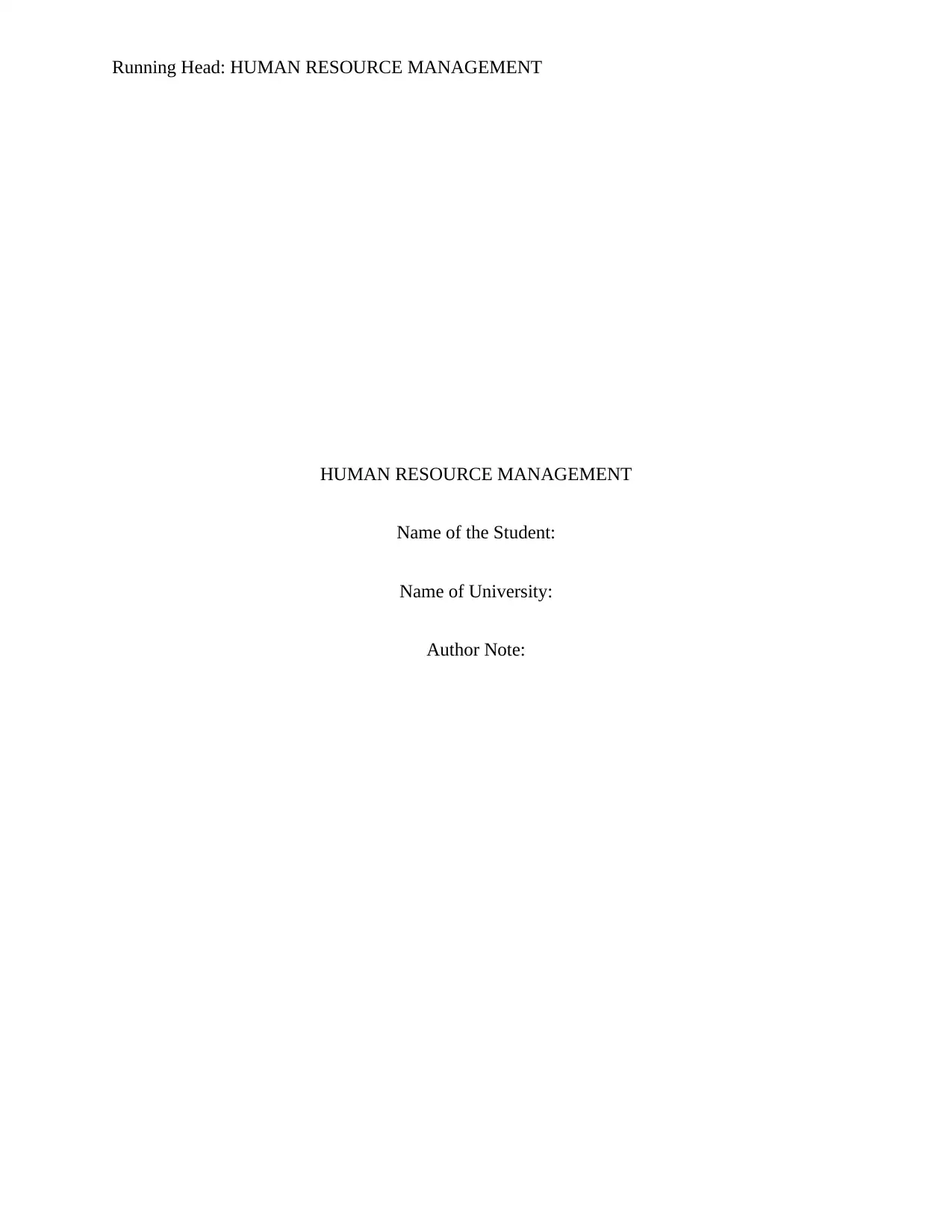
Running Head: HUMAN RESOURCE MANAGEMENT
HUMAN RESOURCE MANAGEMENT
Name of the Student:
Name of University:
Author Note:
HUMAN RESOURCE MANAGEMENT
Name of the Student:
Name of University:
Author Note:
Paraphrase This Document
Need a fresh take? Get an instant paraphrase of this document with our AI Paraphraser
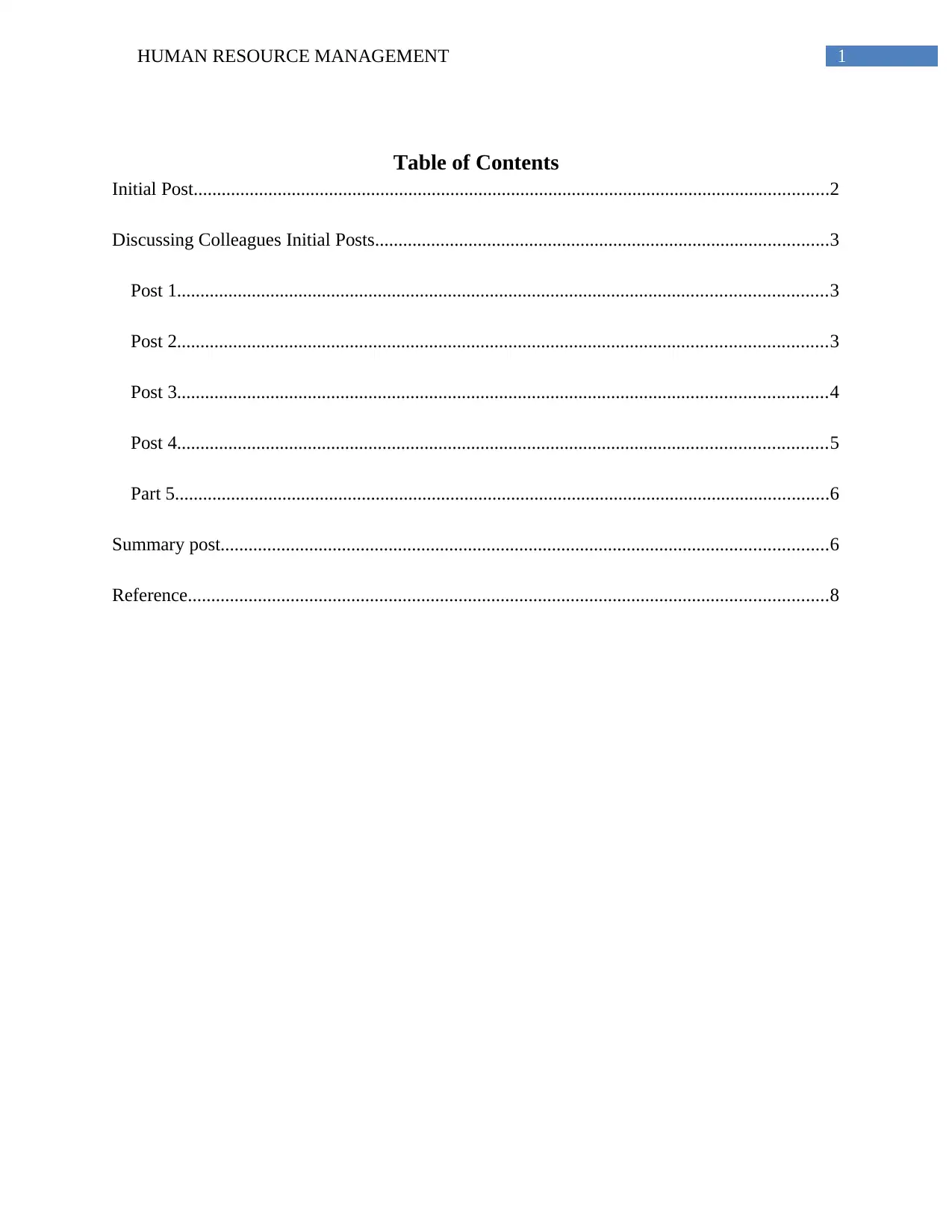
1HUMAN RESOURCE MANAGEMENT
Table of Contents
Initial Post........................................................................................................................................2
Discussing Colleagues Initial Posts.................................................................................................3
Post 1...........................................................................................................................................3
Post 2...........................................................................................................................................3
Post 3...........................................................................................................................................4
Post 4...........................................................................................................................................5
Part 5............................................................................................................................................6
Summary post..................................................................................................................................6
Reference.........................................................................................................................................8
Table of Contents
Initial Post........................................................................................................................................2
Discussing Colleagues Initial Posts.................................................................................................3
Post 1...........................................................................................................................................3
Post 2...........................................................................................................................................3
Post 3...........................................................................................................................................4
Post 4...........................................................................................................................................5
Part 5............................................................................................................................................6
Summary post..................................................................................................................................6
Reference.........................................................................................................................................8
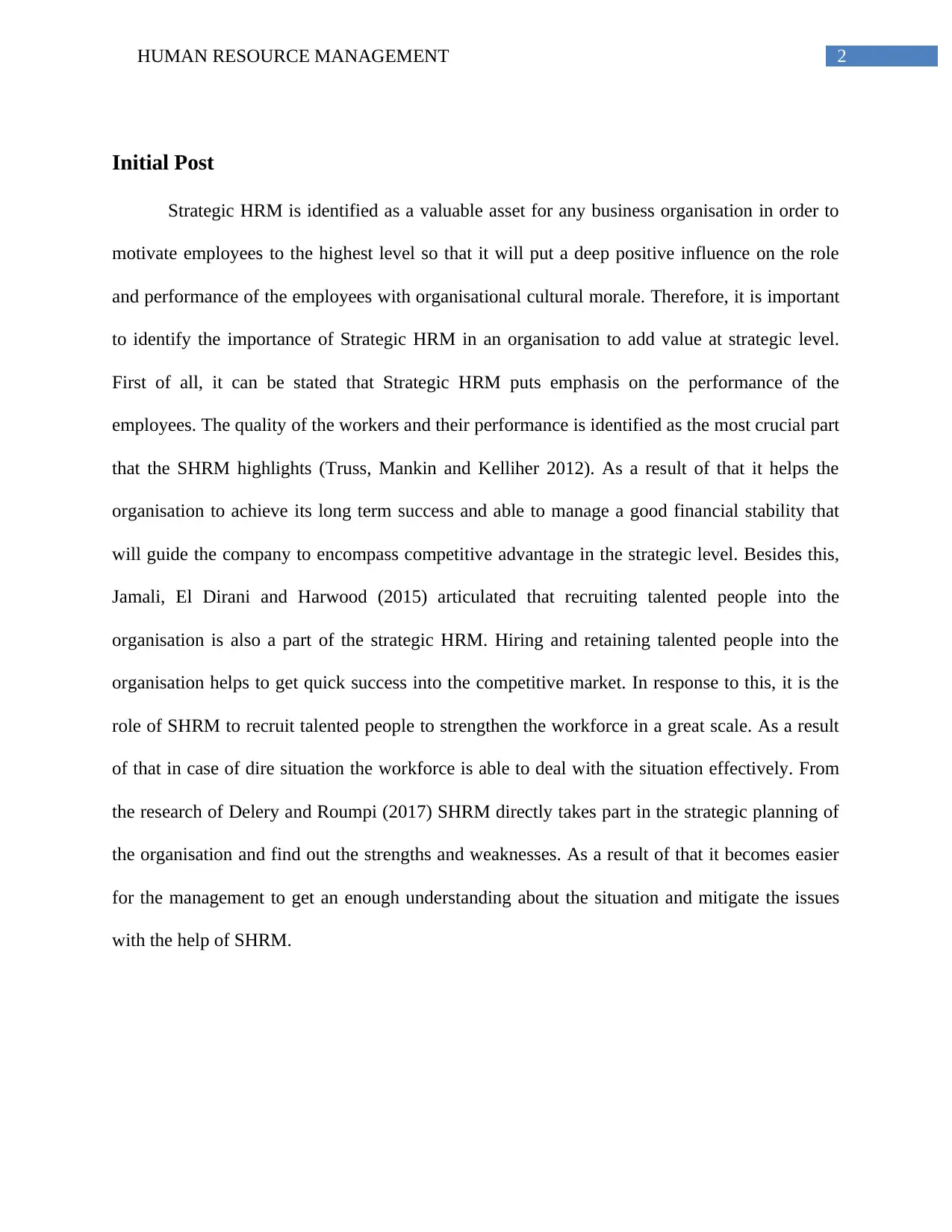
2HUMAN RESOURCE MANAGEMENT
Initial Post
Strategic HRM is identified as a valuable asset for any business organisation in order to
motivate employees to the highest level so that it will put a deep positive influence on the role
and performance of the employees with organisational cultural morale. Therefore, it is important
to identify the importance of Strategic HRM in an organisation to add value at strategic level.
First of all, it can be stated that Strategic HRM puts emphasis on the performance of the
employees. The quality of the workers and their performance is identified as the most crucial part
that the SHRM highlights (Truss, Mankin and Kelliher 2012). As a result of that it helps the
organisation to achieve its long term success and able to manage a good financial stability that
will guide the company to encompass competitive advantage in the strategic level. Besides this,
Jamali, El Dirani and Harwood (2015) articulated that recruiting talented people into the
organisation is also a part of the strategic HRM. Hiring and retaining talented people into the
organisation helps to get quick success into the competitive market. In response to this, it is the
role of SHRM to recruit talented people to strengthen the workforce in a great scale. As a result
of that in case of dire situation the workforce is able to deal with the situation effectively. From
the research of Delery and Roumpi (2017) SHRM directly takes part in the strategic planning of
the organisation and find out the strengths and weaknesses. As a result of that it becomes easier
for the management to get an enough understanding about the situation and mitigate the issues
with the help of SHRM.
Initial Post
Strategic HRM is identified as a valuable asset for any business organisation in order to
motivate employees to the highest level so that it will put a deep positive influence on the role
and performance of the employees with organisational cultural morale. Therefore, it is important
to identify the importance of Strategic HRM in an organisation to add value at strategic level.
First of all, it can be stated that Strategic HRM puts emphasis on the performance of the
employees. The quality of the workers and their performance is identified as the most crucial part
that the SHRM highlights (Truss, Mankin and Kelliher 2012). As a result of that it helps the
organisation to achieve its long term success and able to manage a good financial stability that
will guide the company to encompass competitive advantage in the strategic level. Besides this,
Jamali, El Dirani and Harwood (2015) articulated that recruiting talented people into the
organisation is also a part of the strategic HRM. Hiring and retaining talented people into the
organisation helps to get quick success into the competitive market. In response to this, it is the
role of SHRM to recruit talented people to strengthen the workforce in a great scale. As a result
of that in case of dire situation the workforce is able to deal with the situation effectively. From
the research of Delery and Roumpi (2017) SHRM directly takes part in the strategic planning of
the organisation and find out the strengths and weaknesses. As a result of that it becomes easier
for the management to get an enough understanding about the situation and mitigate the issues
with the help of SHRM.
⊘ This is a preview!⊘
Do you want full access?
Subscribe today to unlock all pages.

Trusted by 1+ million students worldwide
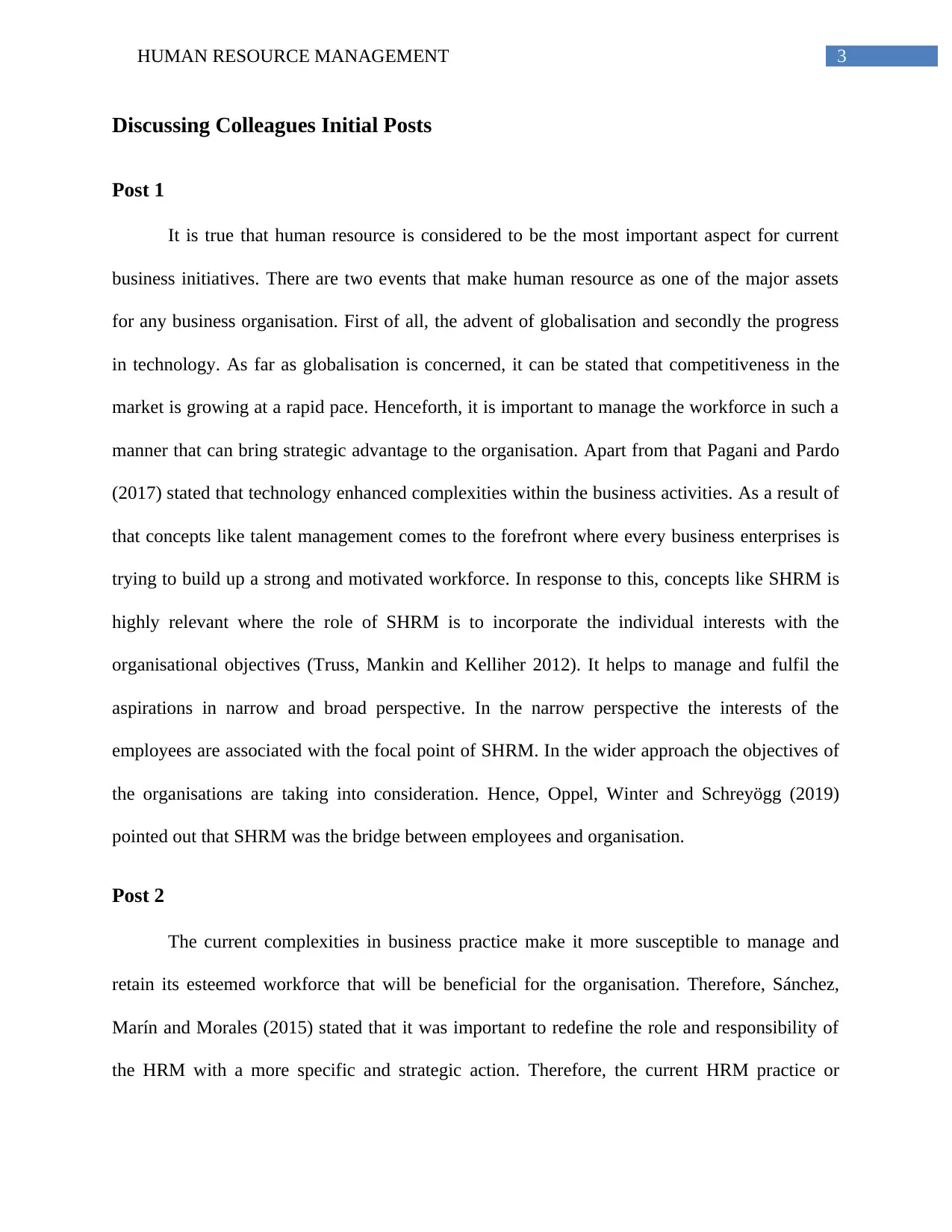
3HUMAN RESOURCE MANAGEMENT
Discussing Colleagues Initial Posts
Post 1
It is true that human resource is considered to be the most important aspect for current
business initiatives. There are two events that make human resource as one of the major assets
for any business organisation. First of all, the advent of globalisation and secondly the progress
in technology. As far as globalisation is concerned, it can be stated that competitiveness in the
market is growing at a rapid pace. Henceforth, it is important to manage the workforce in such a
manner that can bring strategic advantage to the organisation. Apart from that Pagani and Pardo
(2017) stated that technology enhanced complexities within the business activities. As a result of
that concepts like talent management comes to the forefront where every business enterprises is
trying to build up a strong and motivated workforce. In response to this, concepts like SHRM is
highly relevant where the role of SHRM is to incorporate the individual interests with the
organisational objectives (Truss, Mankin and Kelliher 2012). It helps to manage and fulfil the
aspirations in narrow and broad perspective. In the narrow perspective the interests of the
employees are associated with the focal point of SHRM. In the wider approach the objectives of
the organisations are taking into consideration. Hence, Oppel, Winter and Schreyögg (2019)
pointed out that SHRM was the bridge between employees and organisation.
Post 2
The current complexities in business practice make it more susceptible to manage and
retain its esteemed workforce that will be beneficial for the organisation. Therefore, Sánchez,
Marín and Morales (2015) stated that it was important to redefine the role and responsibility of
the HRM with a more specific and strategic action. Therefore, the current HRM practice or
Discussing Colleagues Initial Posts
Post 1
It is true that human resource is considered to be the most important aspect for current
business initiatives. There are two events that make human resource as one of the major assets
for any business organisation. First of all, the advent of globalisation and secondly the progress
in technology. As far as globalisation is concerned, it can be stated that competitiveness in the
market is growing at a rapid pace. Henceforth, it is important to manage the workforce in such a
manner that can bring strategic advantage to the organisation. Apart from that Pagani and Pardo
(2017) stated that technology enhanced complexities within the business activities. As a result of
that concepts like talent management comes to the forefront where every business enterprises is
trying to build up a strong and motivated workforce. In response to this, concepts like SHRM is
highly relevant where the role of SHRM is to incorporate the individual interests with the
organisational objectives (Truss, Mankin and Kelliher 2012). It helps to manage and fulfil the
aspirations in narrow and broad perspective. In the narrow perspective the interests of the
employees are associated with the focal point of SHRM. In the wider approach the objectives of
the organisations are taking into consideration. Hence, Oppel, Winter and Schreyögg (2019)
pointed out that SHRM was the bridge between employees and organisation.
Post 2
The current complexities in business practice make it more susceptible to manage and
retain its esteemed workforce that will be beneficial for the organisation. Therefore, Sánchez,
Marín and Morales (2015) stated that it was important to redefine the role and responsibility of
the HRM with a more specific and strategic action. Therefore, the current HRM practice or
Paraphrase This Document
Need a fresh take? Get an instant paraphrase of this document with our AI Paraphraser
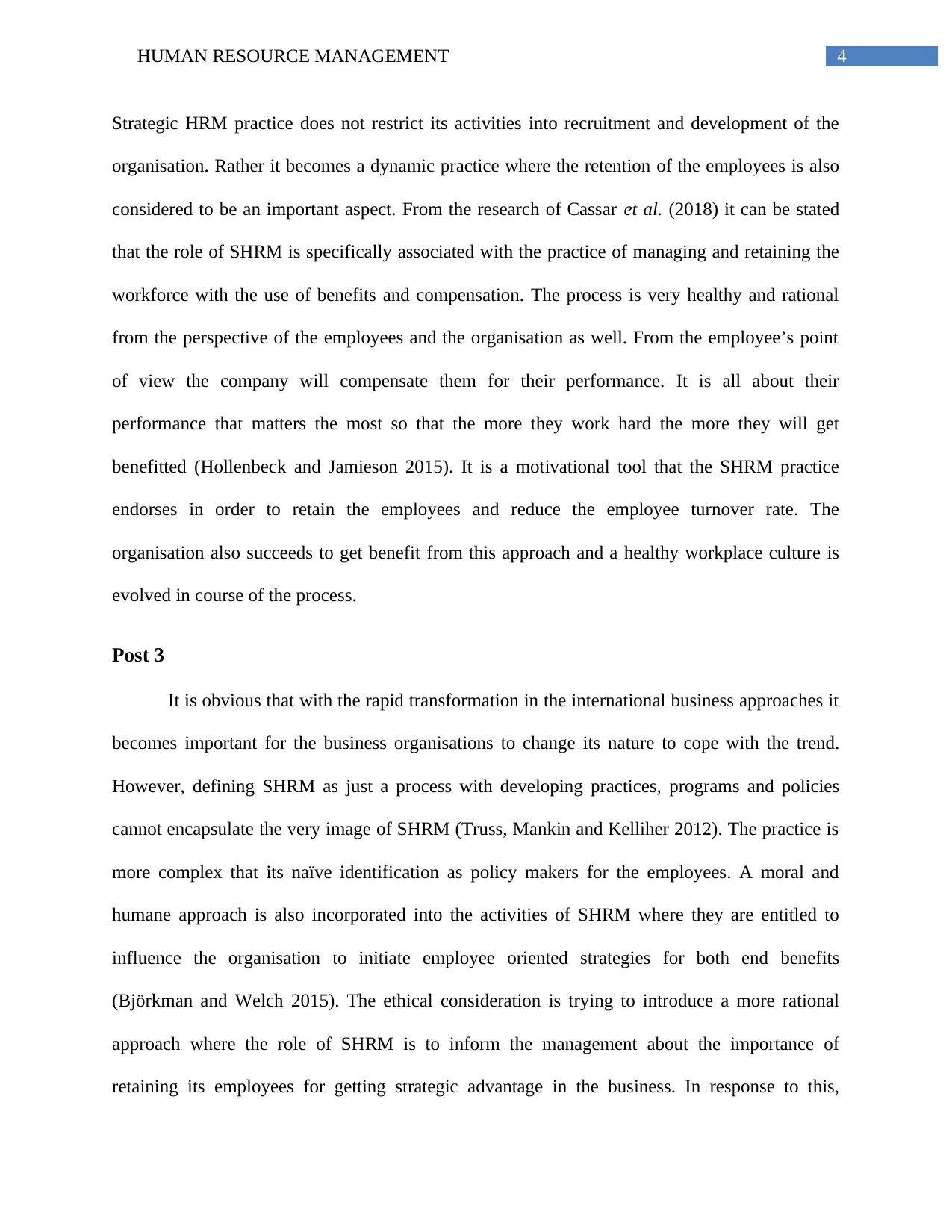
4HUMAN RESOURCE MANAGEMENT
Strategic HRM practice does not restrict its activities into recruitment and development of the
organisation. Rather it becomes a dynamic practice where the retention of the employees is also
considered to be an important aspect. From the research of Cassar et al. (2018) it can be stated
that the role of SHRM is specifically associated with the practice of managing and retaining the
workforce with the use of benefits and compensation. The process is very healthy and rational
from the perspective of the employees and the organisation as well. From the employee’s point
of view the company will compensate them for their performance. It is all about their
performance that matters the most so that the more they work hard the more they will get
benefitted (Hollenbeck and Jamieson 2015). It is a motivational tool that the SHRM practice
endorses in order to retain the employees and reduce the employee turnover rate. The
organisation also succeeds to get benefit from this approach and a healthy workplace culture is
evolved in course of the process.
Post 3
It is obvious that with the rapid transformation in the international business approaches it
becomes important for the business organisations to change its nature to cope with the trend.
However, defining SHRM as just a process with developing practices, programs and policies
cannot encapsulate the very image of SHRM (Truss, Mankin and Kelliher 2012). The practice is
more complex that its naïve identification as policy makers for the employees. A moral and
humane approach is also incorporated into the activities of SHRM where they are entitled to
influence the organisation to initiate employee oriented strategies for both end benefits
(Björkman and Welch 2015). The ethical consideration is trying to introduce a more rational
approach where the role of SHRM is to inform the management about the importance of
retaining its employees for getting strategic advantage in the business. In response to this,
Strategic HRM practice does not restrict its activities into recruitment and development of the
organisation. Rather it becomes a dynamic practice where the retention of the employees is also
considered to be an important aspect. From the research of Cassar et al. (2018) it can be stated
that the role of SHRM is specifically associated with the practice of managing and retaining the
workforce with the use of benefits and compensation. The process is very healthy and rational
from the perspective of the employees and the organisation as well. From the employee’s point
of view the company will compensate them for their performance. It is all about their
performance that matters the most so that the more they work hard the more they will get
benefitted (Hollenbeck and Jamieson 2015). It is a motivational tool that the SHRM practice
endorses in order to retain the employees and reduce the employee turnover rate. The
organisation also succeeds to get benefit from this approach and a healthy workplace culture is
evolved in course of the process.
Post 3
It is obvious that with the rapid transformation in the international business approaches it
becomes important for the business organisations to change its nature to cope with the trend.
However, defining SHRM as just a process with developing practices, programs and policies
cannot encapsulate the very image of SHRM (Truss, Mankin and Kelliher 2012). The practice is
more complex that its naïve identification as policy makers for the employees. A moral and
humane approach is also incorporated into the activities of SHRM where they are entitled to
influence the organisation to initiate employee oriented strategies for both end benefits
(Björkman and Welch 2015). The ethical consideration is trying to introduce a more rational
approach where the role of SHRM is to inform the management about the importance of
retaining its employees for getting strategic advantage in the business. In response to this,
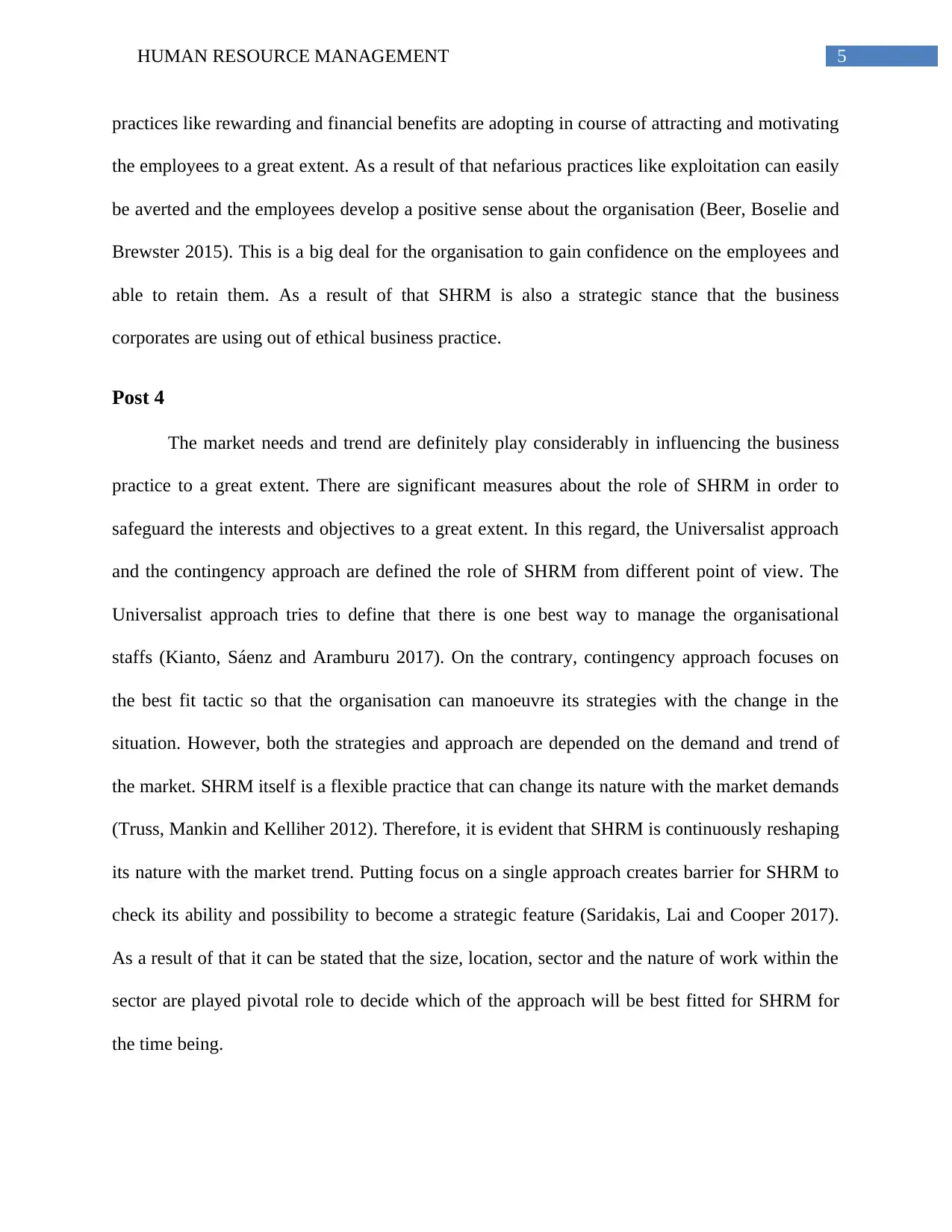
5HUMAN RESOURCE MANAGEMENT
practices like rewarding and financial benefits are adopting in course of attracting and motivating
the employees to a great extent. As a result of that nefarious practices like exploitation can easily
be averted and the employees develop a positive sense about the organisation (Beer, Boselie and
Brewster 2015). This is a big deal for the organisation to gain confidence on the employees and
able to retain them. As a result of that SHRM is also a strategic stance that the business
corporates are using out of ethical business practice.
Post 4
The market needs and trend are definitely play considerably in influencing the business
practice to a great extent. There are significant measures about the role of SHRM in order to
safeguard the interests and objectives to a great extent. In this regard, the Universalist approach
and the contingency approach are defined the role of SHRM from different point of view. The
Universalist approach tries to define that there is one best way to manage the organisational
staffs (Kianto, Sáenz and Aramburu 2017). On the contrary, contingency approach focuses on
the best fit tactic so that the organisation can manoeuvre its strategies with the change in the
situation. However, both the strategies and approach are depended on the demand and trend of
the market. SHRM itself is a flexible practice that can change its nature with the market demands
(Truss, Mankin and Kelliher 2012). Therefore, it is evident that SHRM is continuously reshaping
its nature with the market trend. Putting focus on a single approach creates barrier for SHRM to
check its ability and possibility to become a strategic feature (Saridakis, Lai and Cooper 2017).
As a result of that it can be stated that the size, location, sector and the nature of work within the
sector are played pivotal role to decide which of the approach will be best fitted for SHRM for
the time being.
practices like rewarding and financial benefits are adopting in course of attracting and motivating
the employees to a great extent. As a result of that nefarious practices like exploitation can easily
be averted and the employees develop a positive sense about the organisation (Beer, Boselie and
Brewster 2015). This is a big deal for the organisation to gain confidence on the employees and
able to retain them. As a result of that SHRM is also a strategic stance that the business
corporates are using out of ethical business practice.
Post 4
The market needs and trend are definitely play considerably in influencing the business
practice to a great extent. There are significant measures about the role of SHRM in order to
safeguard the interests and objectives to a great extent. In this regard, the Universalist approach
and the contingency approach are defined the role of SHRM from different point of view. The
Universalist approach tries to define that there is one best way to manage the organisational
staffs (Kianto, Sáenz and Aramburu 2017). On the contrary, contingency approach focuses on
the best fit tactic so that the organisation can manoeuvre its strategies with the change in the
situation. However, both the strategies and approach are depended on the demand and trend of
the market. SHRM itself is a flexible practice that can change its nature with the market demands
(Truss, Mankin and Kelliher 2012). Therefore, it is evident that SHRM is continuously reshaping
its nature with the market trend. Putting focus on a single approach creates barrier for SHRM to
check its ability and possibility to become a strategic feature (Saridakis, Lai and Cooper 2017).
As a result of that it can be stated that the size, location, sector and the nature of work within the
sector are played pivotal role to decide which of the approach will be best fitted for SHRM for
the time being.
⊘ This is a preview!⊘
Do you want full access?
Subscribe today to unlock all pages.

Trusted by 1+ million students worldwide
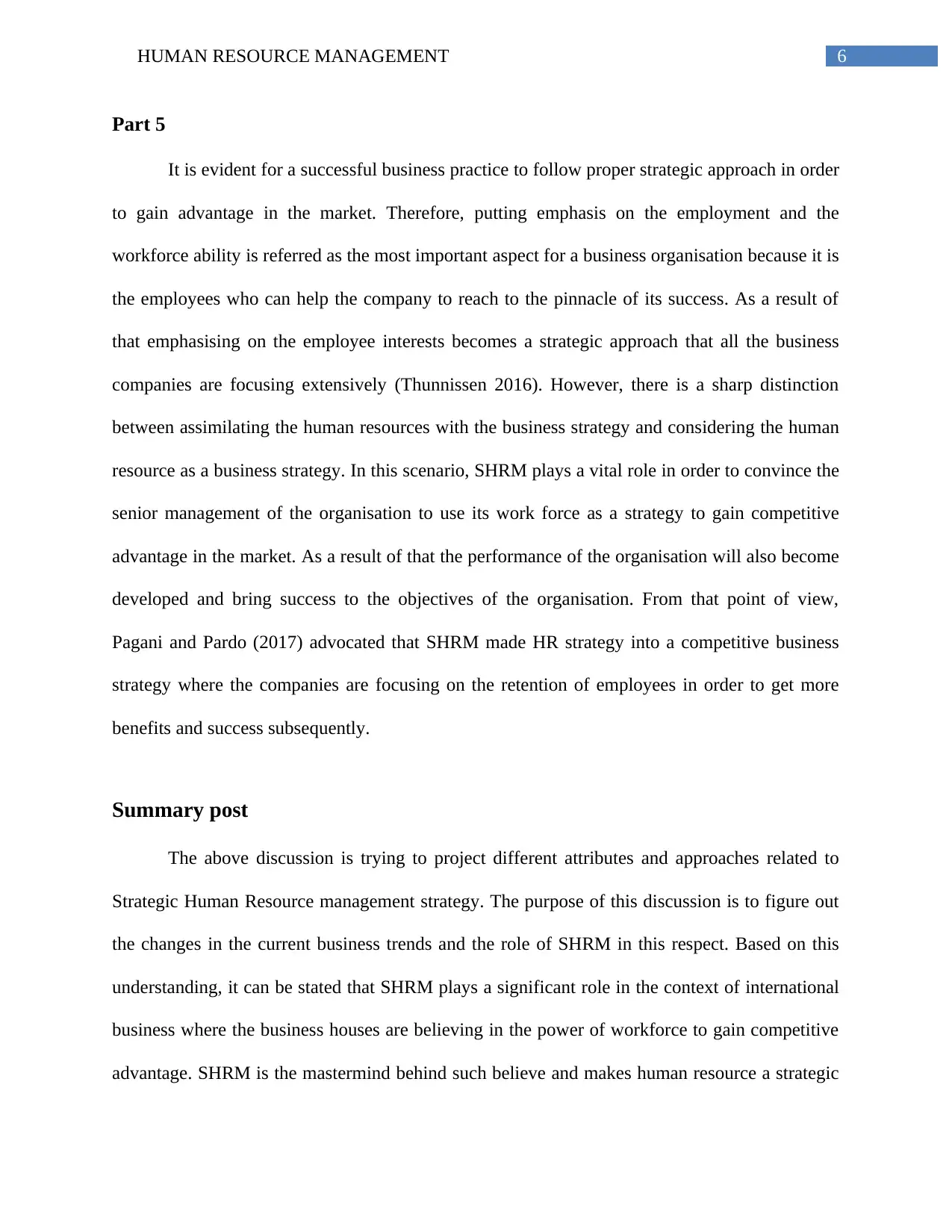
6HUMAN RESOURCE MANAGEMENT
Part 5
It is evident for a successful business practice to follow proper strategic approach in order
to gain advantage in the market. Therefore, putting emphasis on the employment and the
workforce ability is referred as the most important aspect for a business organisation because it is
the employees who can help the company to reach to the pinnacle of its success. As a result of
that emphasising on the employee interests becomes a strategic approach that all the business
companies are focusing extensively (Thunnissen 2016). However, there is a sharp distinction
between assimilating the human resources with the business strategy and considering the human
resource as a business strategy. In this scenario, SHRM plays a vital role in order to convince the
senior management of the organisation to use its work force as a strategy to gain competitive
advantage in the market. As a result of that the performance of the organisation will also become
developed and bring success to the objectives of the organisation. From that point of view,
Pagani and Pardo (2017) advocated that SHRM made HR strategy into a competitive business
strategy where the companies are focusing on the retention of employees in order to get more
benefits and success subsequently.
Summary post
The above discussion is trying to project different attributes and approaches related to
Strategic Human Resource management strategy. The purpose of this discussion is to figure out
the changes in the current business trends and the role of SHRM in this respect. Based on this
understanding, it can be stated that SHRM plays a significant role in the context of international
business where the business houses are believing in the power of workforce to gain competitive
advantage. SHRM is the mastermind behind such believe and makes human resource a strategic
Part 5
It is evident for a successful business practice to follow proper strategic approach in order
to gain advantage in the market. Therefore, putting emphasis on the employment and the
workforce ability is referred as the most important aspect for a business organisation because it is
the employees who can help the company to reach to the pinnacle of its success. As a result of
that emphasising on the employee interests becomes a strategic approach that all the business
companies are focusing extensively (Thunnissen 2016). However, there is a sharp distinction
between assimilating the human resources with the business strategy and considering the human
resource as a business strategy. In this scenario, SHRM plays a vital role in order to convince the
senior management of the organisation to use its work force as a strategy to gain competitive
advantage in the market. As a result of that the performance of the organisation will also become
developed and bring success to the objectives of the organisation. From that point of view,
Pagani and Pardo (2017) advocated that SHRM made HR strategy into a competitive business
strategy where the companies are focusing on the retention of employees in order to get more
benefits and success subsequently.
Summary post
The above discussion is trying to project different attributes and approaches related to
Strategic Human Resource management strategy. The purpose of this discussion is to figure out
the changes in the current business trends and the role of SHRM in this respect. Based on this
understanding, it can be stated that SHRM plays a significant role in the context of international
business where the business houses are believing in the power of workforce to gain competitive
advantage. SHRM is the mastermind behind such believe and makes human resource a strategic
Paraphrase This Document
Need a fresh take? Get an instant paraphrase of this document with our AI Paraphraser
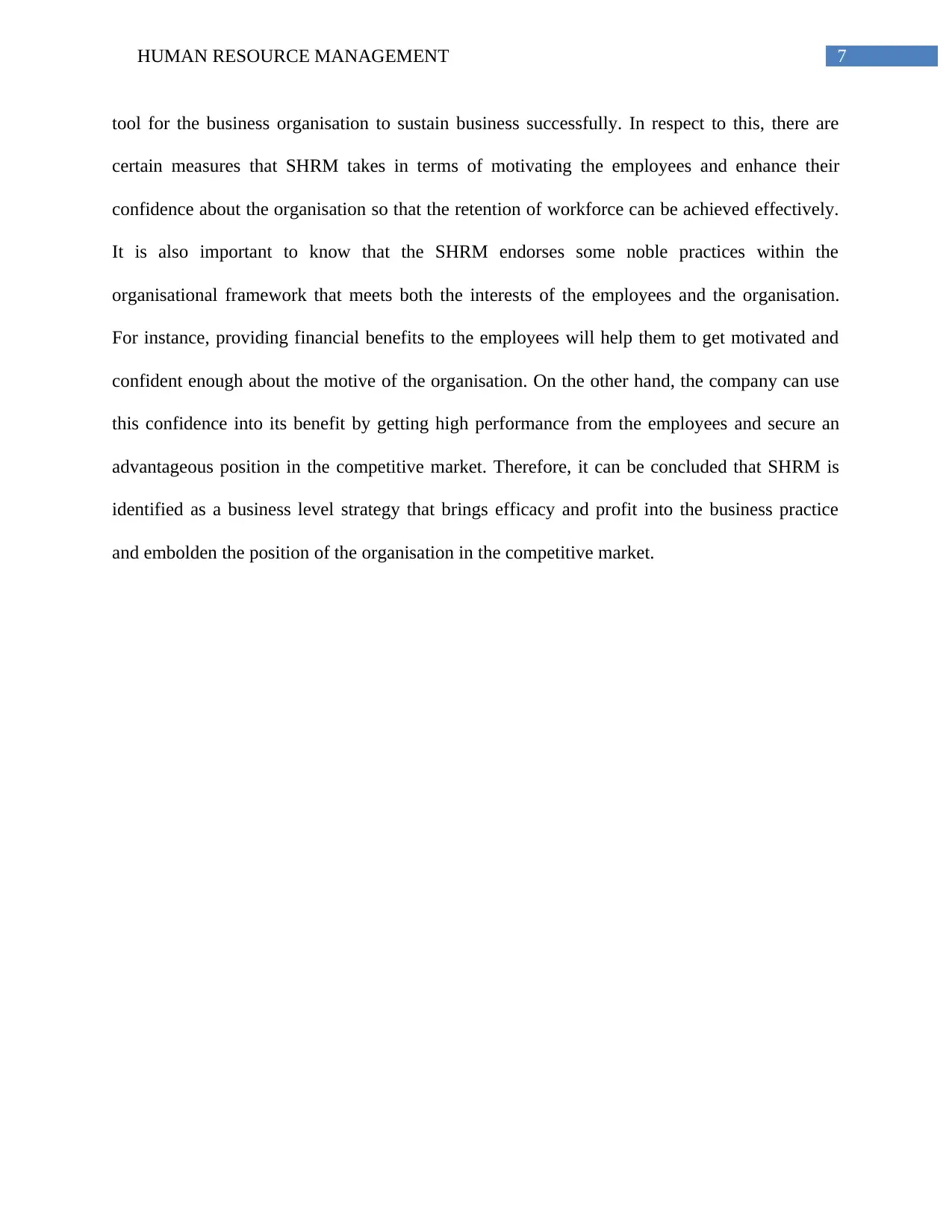
7HUMAN RESOURCE MANAGEMENT
tool for the business organisation to sustain business successfully. In respect to this, there are
certain measures that SHRM takes in terms of motivating the employees and enhance their
confidence about the organisation so that the retention of workforce can be achieved effectively.
It is also important to know that the SHRM endorses some noble practices within the
organisational framework that meets both the interests of the employees and the organisation.
For instance, providing financial benefits to the employees will help them to get motivated and
confident enough about the motive of the organisation. On the other hand, the company can use
this confidence into its benefit by getting high performance from the employees and secure an
advantageous position in the competitive market. Therefore, it can be concluded that SHRM is
identified as a business level strategy that brings efficacy and profit into the business practice
and embolden the position of the organisation in the competitive market.
tool for the business organisation to sustain business successfully. In respect to this, there are
certain measures that SHRM takes in terms of motivating the employees and enhance their
confidence about the organisation so that the retention of workforce can be achieved effectively.
It is also important to know that the SHRM endorses some noble practices within the
organisational framework that meets both the interests of the employees and the organisation.
For instance, providing financial benefits to the employees will help them to get motivated and
confident enough about the motive of the organisation. On the other hand, the company can use
this confidence into its benefit by getting high performance from the employees and secure an
advantageous position in the competitive market. Therefore, it can be concluded that SHRM is
identified as a business level strategy that brings efficacy and profit into the business practice
and embolden the position of the organisation in the competitive market.
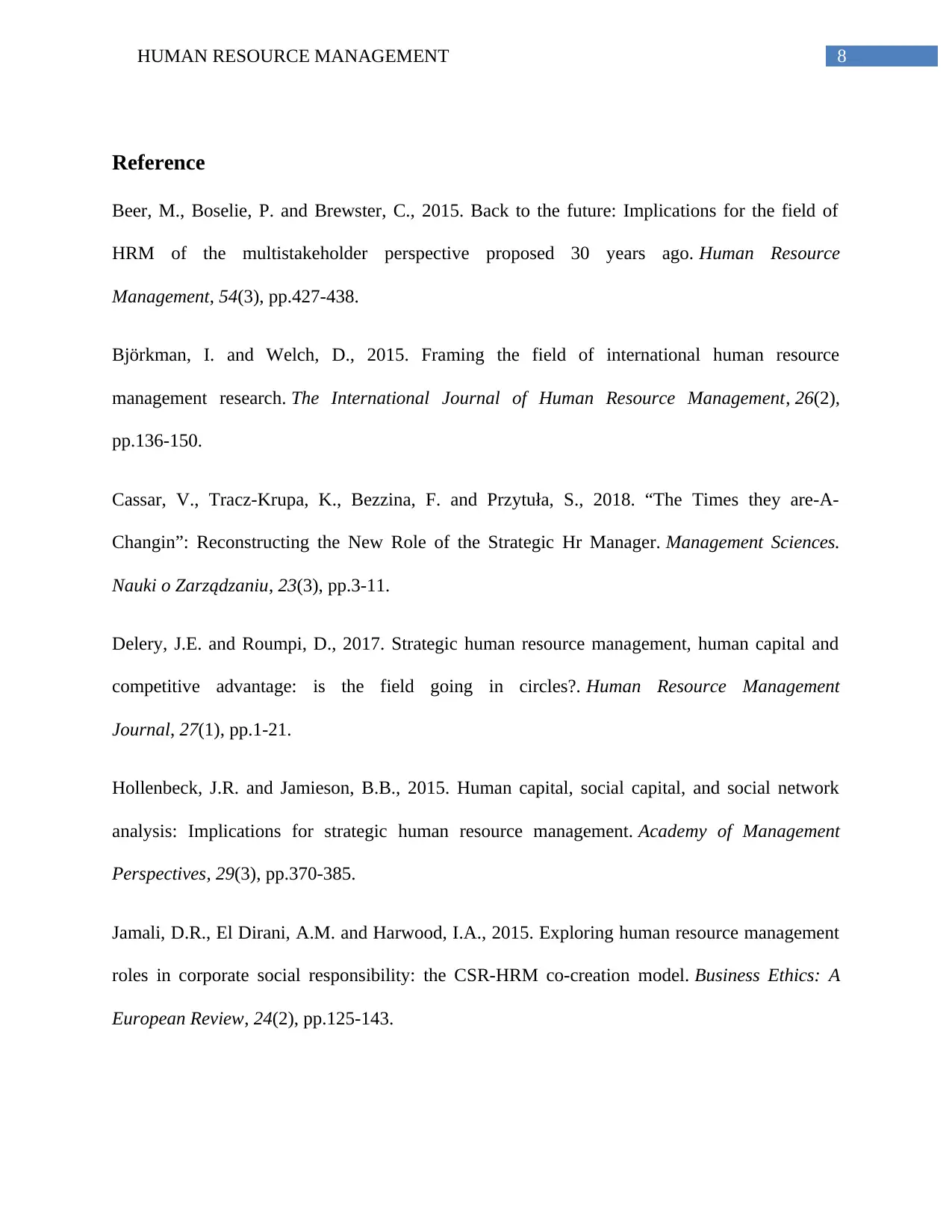
8HUMAN RESOURCE MANAGEMENT
Reference
Beer, M., Boselie, P. and Brewster, C., 2015. Back to the future: Implications for the field of
HRM of the multistakeholder perspective proposed 30 years ago. Human Resource
Management, 54(3), pp.427-438.
Björkman, I. and Welch, D., 2015. Framing the field of international human resource
management research. The International Journal of Human Resource Management, 26(2),
pp.136-150.
Cassar, V., Tracz-Krupa, K., Bezzina, F. and Przytuła, S., 2018. “The Times they are-A-
Changin”: Reconstructing the New Role of the Strategic Hr Manager. Management Sciences.
Nauki o Zarządzaniu, 23(3), pp.3-11.
Delery, J.E. and Roumpi, D., 2017. Strategic human resource management, human capital and
competitive advantage: is the field going in circles?. Human Resource Management
Journal, 27(1), pp.1-21.
Hollenbeck, J.R. and Jamieson, B.B., 2015. Human capital, social capital, and social network
analysis: Implications for strategic human resource management. Academy of Management
Perspectives, 29(3), pp.370-385.
Jamali, D.R., El Dirani, A.M. and Harwood, I.A., 2015. Exploring human resource management
roles in corporate social responsibility: the CSR‐HRM co‐creation model. Business Ethics: A
European Review, 24(2), pp.125-143.
Reference
Beer, M., Boselie, P. and Brewster, C., 2015. Back to the future: Implications for the field of
HRM of the multistakeholder perspective proposed 30 years ago. Human Resource
Management, 54(3), pp.427-438.
Björkman, I. and Welch, D., 2015. Framing the field of international human resource
management research. The International Journal of Human Resource Management, 26(2),
pp.136-150.
Cassar, V., Tracz-Krupa, K., Bezzina, F. and Przytuła, S., 2018. “The Times they are-A-
Changin”: Reconstructing the New Role of the Strategic Hr Manager. Management Sciences.
Nauki o Zarządzaniu, 23(3), pp.3-11.
Delery, J.E. and Roumpi, D., 2017. Strategic human resource management, human capital and
competitive advantage: is the field going in circles?. Human Resource Management
Journal, 27(1), pp.1-21.
Hollenbeck, J.R. and Jamieson, B.B., 2015. Human capital, social capital, and social network
analysis: Implications for strategic human resource management. Academy of Management
Perspectives, 29(3), pp.370-385.
Jamali, D.R., El Dirani, A.M. and Harwood, I.A., 2015. Exploring human resource management
roles in corporate social responsibility: the CSR‐HRM co‐creation model. Business Ethics: A
European Review, 24(2), pp.125-143.
⊘ This is a preview!⊘
Do you want full access?
Subscribe today to unlock all pages.

Trusted by 1+ million students worldwide
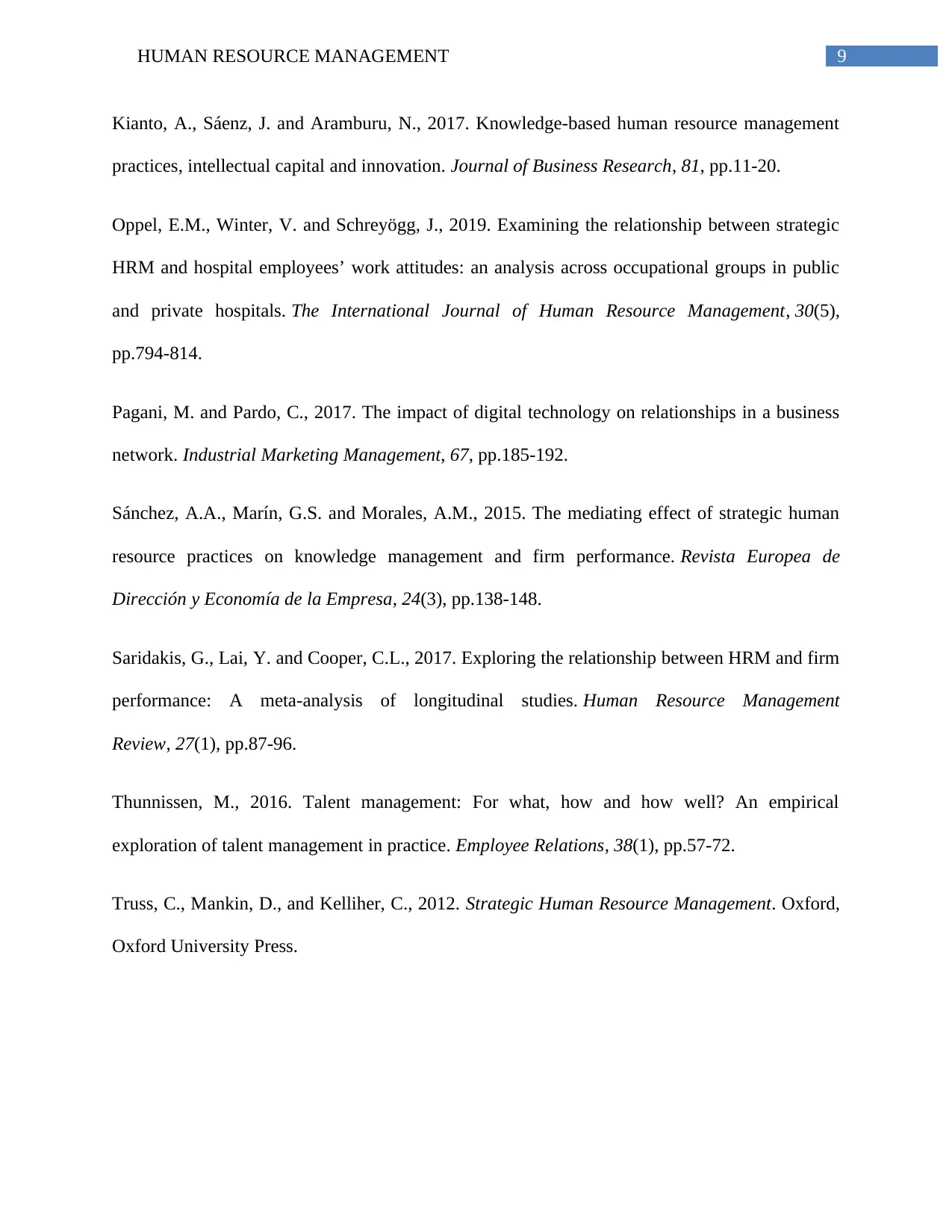
9HUMAN RESOURCE MANAGEMENT
Kianto, A., Sáenz, J. and Aramburu, N., 2017. Knowledge-based human resource management
practices, intellectual capital and innovation. Journal of Business Research, 81, pp.11-20.
Oppel, E.M., Winter, V. and Schreyögg, J., 2019. Examining the relationship between strategic
HRM and hospital employees’ work attitudes: an analysis across occupational groups in public
and private hospitals. The International Journal of Human Resource Management, 30(5),
pp.794-814.
Pagani, M. and Pardo, C., 2017. The impact of digital technology on relationships in a business
network. Industrial Marketing Management, 67, pp.185-192.
Sánchez, A.A., Marín, G.S. and Morales, A.M., 2015. The mediating effect of strategic human
resource practices on knowledge management and firm performance. Revista Europea de
Dirección y Economía de la Empresa, 24(3), pp.138-148.
Saridakis, G., Lai, Y. and Cooper, C.L., 2017. Exploring the relationship between HRM and firm
performance: A meta-analysis of longitudinal studies. Human Resource Management
Review, 27(1), pp.87-96.
Thunnissen, M., 2016. Talent management: For what, how and how well? An empirical
exploration of talent management in practice. Employee Relations, 38(1), pp.57-72.
Truss, C., Mankin, D., and Kelliher, C., 2012. Strategic Human Resource Management. Oxford,
Oxford University Press.
Kianto, A., Sáenz, J. and Aramburu, N., 2017. Knowledge-based human resource management
practices, intellectual capital and innovation. Journal of Business Research, 81, pp.11-20.
Oppel, E.M., Winter, V. and Schreyögg, J., 2019. Examining the relationship between strategic
HRM and hospital employees’ work attitudes: an analysis across occupational groups in public
and private hospitals. The International Journal of Human Resource Management, 30(5),
pp.794-814.
Pagani, M. and Pardo, C., 2017. The impact of digital technology on relationships in a business
network. Industrial Marketing Management, 67, pp.185-192.
Sánchez, A.A., Marín, G.S. and Morales, A.M., 2015. The mediating effect of strategic human
resource practices on knowledge management and firm performance. Revista Europea de
Dirección y Economía de la Empresa, 24(3), pp.138-148.
Saridakis, G., Lai, Y. and Cooper, C.L., 2017. Exploring the relationship between HRM and firm
performance: A meta-analysis of longitudinal studies. Human Resource Management
Review, 27(1), pp.87-96.
Thunnissen, M., 2016. Talent management: For what, how and how well? An empirical
exploration of talent management in practice. Employee Relations, 38(1), pp.57-72.
Truss, C., Mankin, D., and Kelliher, C., 2012. Strategic Human Resource Management. Oxford,
Oxford University Press.
1 out of 10
Related Documents
Your All-in-One AI-Powered Toolkit for Academic Success.
+13062052269
info@desklib.com
Available 24*7 on WhatsApp / Email
![[object Object]](/_next/static/media/star-bottom.7253800d.svg)
Unlock your academic potential
Copyright © 2020–2025 A2Z Services. All Rights Reserved. Developed and managed by ZUCOL.





